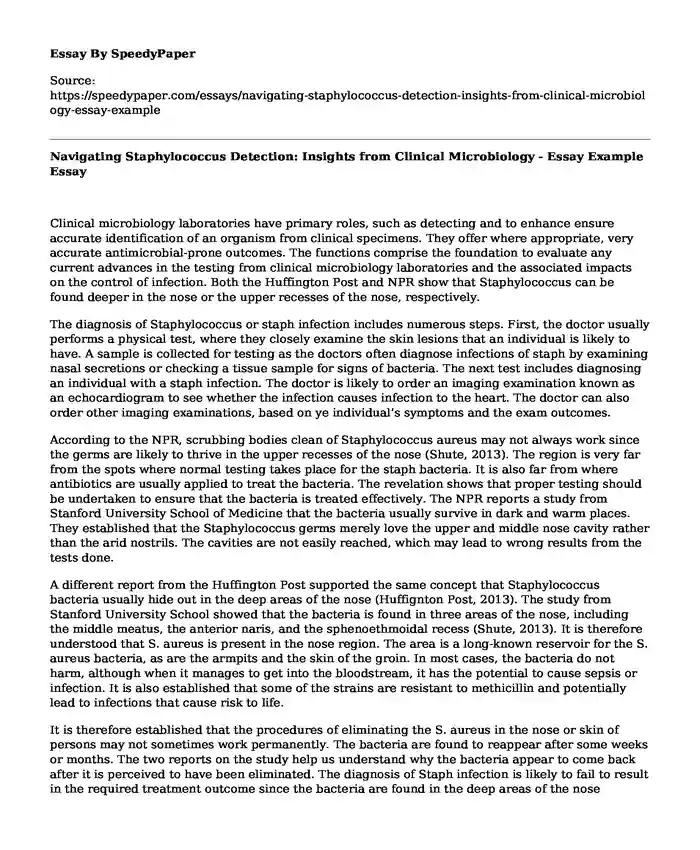
| Type of paper: | Essay |
| Categories: | Biology |
| Pages: | 3 |
| Wordcount: | 620 words |
Clinical microbiology laboratories have primary roles, such as detecting and to enhance ensure accurate identification of an organism from clinical specimens. They offer where appropriate, very accurate antimicrobial-prone outcomes. The functions comprise the foundation to evaluate any current advances in the testing from clinical microbiology laboratories and the associated impacts on the control of infection. Both the Huffington Post and NPR show that Staphylococcus can be found deeper in the nose or the upper recesses of the nose, respectively.
The diagnosis of Staphylococcus or staph infection includes numerous steps. First, the doctor usually performs a physical test, where they closely examine the skin lesions that an individual is likely to have. A sample is collected for testing as the doctors often diagnose infections of staph by examining nasal secretions or checking a tissue sample for signs of bacteria. The next test includes diagnosing an individual with a staph infection. The doctor is likely to order an imaging examination known as an echocardiogram to see whether the infection causes infection to the heart. The doctor can also order other imaging examinations, based on ye individual’s symptoms and the exam outcomes.
According to the NPR, scrubbing bodies clean of Staphylococcus aureus may not always work since the germs are likely to thrive in the upper recesses of the nose (Shute, 2013). The region is very far from the spots where normal testing takes place for the staph bacteria. It is also far from where antibiotics are usually applied to treat the bacteria. The revelation shows that proper testing should be undertaken to ensure that the bacteria is treated effectively. The NPR reports a study from Stanford University School of Medicine that the bacteria usually survive in dark and warm places. They established that the Staphylococcus germs merely love the upper and middle nose cavity rather than the arid nostrils. The cavities are not easily reached, which may lead to wrong results from the tests done.
A different report from the Huffington Post supported the same concept that Staphylococcus bacteria usually hide out in the deep areas of the nose (Huffignton Post, 2013). The study from Stanford University School showed that the bacteria is found in three areas of the nose, including the middle meatus, the anterior naris, and the sphenoethmoidal recess (Shute, 2013). It is therefore understood that S. aureus is present in the nose region. The area is a long-known reservoir for the S. aureus bacteria, as are the armpits and the skin of the groin. In most cases, the bacteria do not harm, although when it manages to get into the bloodstream, it has the potential to cause sepsis or infection. It is also established that some of the strains are resistant to methicillin and potentially lead to infections that cause risk to life.
It is therefore established that the procedures of eliminating the S. aureus in the nose or skin of persons may not sometimes work permanently. The bacteria are found to reappear after some weeks or months. The two reports on the study help us understand why the bacteria appear to come back after it is perceived to have been eliminated. The diagnosis of Staph infection is likely to fail to result in the required treatment outcome since the bacteria are found in the deep areas of the nose (Huffignton Post, 2013). The information from the study is useful for the clinical purpose to ensure proper testing is performed. It allows for better ways of enhancing the situation of the bacteria.
References
Huffignton Post. (2013). Staphyloccocus Aureus Bacteria Hide Out Deep In The Nose. https://www.huffpost.com/entry/staphyloccocus-aureus-nose-staph-bacteria_n_4421243
Shute, N. (2013). Staph Germs Hide Out In The Hidden Recesses Of Your Nose. https://www.npr.org/sections/health-shots/2013/12/10/250026572/staph-germs-hide-out-in-the-hidden-recesses-of-your-nose/
Cite this page
Navigating Staphylococcus Detection: Insights from Clinical Microbiology - Essay Example. (2023, Dec 06). Retrieved from https://speedypaper.com/essays/navigating-staphylococcus-detection-insights-from-clinical-microbiology-essay-example
Request Removal
If you are the original author of this essay and no longer wish to have it published on the SpeedyPaper website, please click below to request its removal:
- Free Essay Example on Kashmir Dispute
- Free Essay on Risk and Reward of Design-Build Method of Delivery
- Resistance to Civil Government by Henry David Thoreau - Essay Example
- Essay Example on Conceptualizations of Hegemony and Habitus
- Paper Example. Materials Science Behind Running Shoe
- Paper Example: Bloom's Taxonomy
- Exploring Mycobacterium Leprae: Structure, Epidemiology, and Management of Hansen's Disease - Essay Sample
Popular categories




